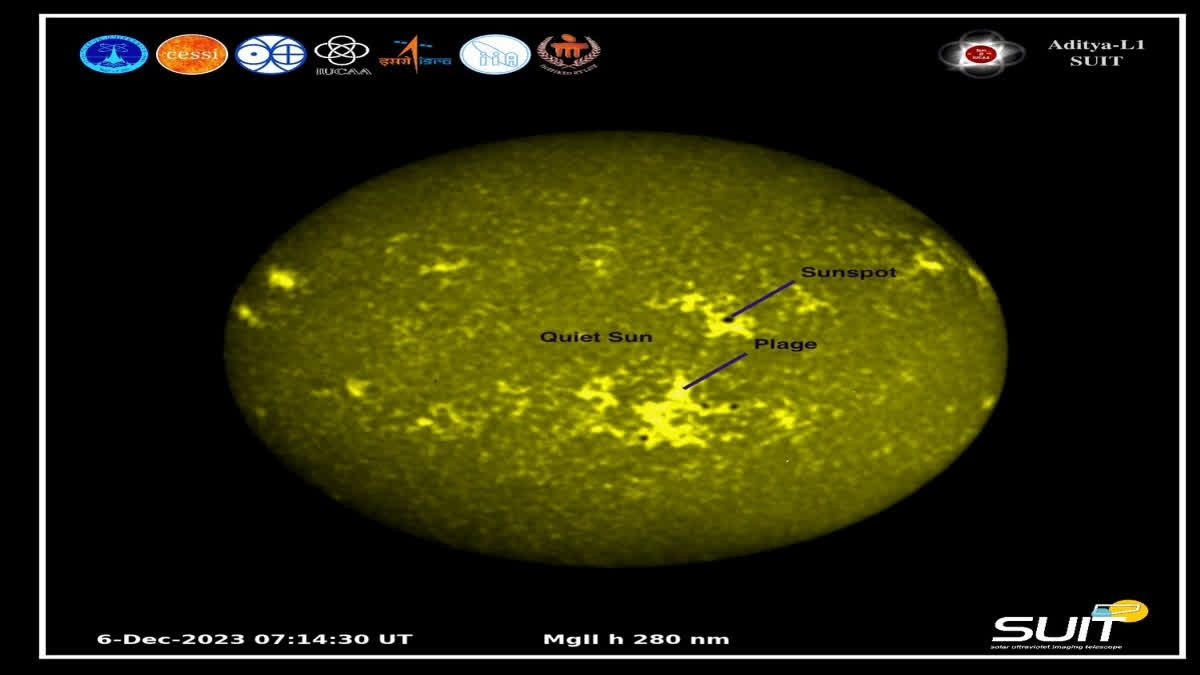Hyderabad: The Indian Space Research Organisation (ISRO) on Friday shared the first-ever full-disk images of the Sun that were captured by India's Aditya-L1 Mission. ISRO took to X (previously known as Twitter) and shared the Sun pictures--in near ultraviolent wavelengths ranging from 200 to 400 nm. "provide pioneering insights into the intricate details of the Sun's photosphere and chromosphere," ISRO posted on X.
"The Solar Ultraviolet Imaging Telescope (SUIT) instrument on board the Aditya-L1 spacecraft has successfully captured the first full-disk images of the Sun in the 200-400 nm wavelength range. SUIT captures images of the Sun's photosphere and chromosphere in this wavelength range using various scientific filters", said ISRO.
-
Aditya-L1 Mission:
— ISRO (@isro) December 8, 2023 " class="align-text-top noRightClick twitterSection" data="
The SUIT payload captures full-disk images of the Sun in near ultraviolet wavelengths
The images include the first-ever full-disk representations of the Sun in wavelengths ranging from 200 to 400 nm.
They provide pioneering insights into the intricate details… pic.twitter.com/YBAYJ3YkUy
">Aditya-L1 Mission:
— ISRO (@isro) December 8, 2023
The SUIT payload captures full-disk images of the Sun in near ultraviolet wavelengths
The images include the first-ever full-disk representations of the Sun in wavelengths ranging from 200 to 400 nm.
They provide pioneering insights into the intricate details… pic.twitter.com/YBAYJ3YkUyAditya-L1 Mission:
— ISRO (@isro) December 8, 2023
The SUIT payload captures full-disk images of the Sun in near ultraviolet wavelengths
The images include the first-ever full-disk representations of the Sun in wavelengths ranging from 200 to 400 nm.
They provide pioneering insights into the intricate details… pic.twitter.com/YBAYJ3YkUy
On November 20, 2023, the SUIT payload was powered on. Following a successful pre-commissioning phase, the telescope captured its first light science images on December 6, 2023. These unprecedented images, taken using 11 different filters (as shown in Table 1), include the first-ever full-disk representations of the Sun in wavelengths ranging from 200 to 400 nm, excluding Ca II h. The full disk images of the Sun in the Ca II h wavelength has been studied from other observatories.
Among the notable features revealed are sunspots, plage, and quiet Sun regions, as marked in the Mg II h image, providing scientists with pioneering insights into the intricate details of the Sun's photosphere and chromosphere. SUIT observations will help scientists study the dynamic coupling of the magnetised solar atmosphere and assist them in placing tight constraints on the effects of solar radiation on Earth's climate
The development of SUIT involved a collaborative effort under the leadership of the Inter-University Centre for Astronomy and Astrophysics (IUCAA), Pune. This collaboration included ISRO, the Manipal Academy of Higher Education (MAHE), the Centre for Excellence in Space Science Indian (CESSI) at IISER-Kolkata, the Indian Institute of Astrophysics Bengaluru, the Udaipur Solar Observatory (USO-PRL), and Tezpur University Assam.
Also read: Solar wind particle experiment payload onboard Aditya-L1 starts operations: ISRO



